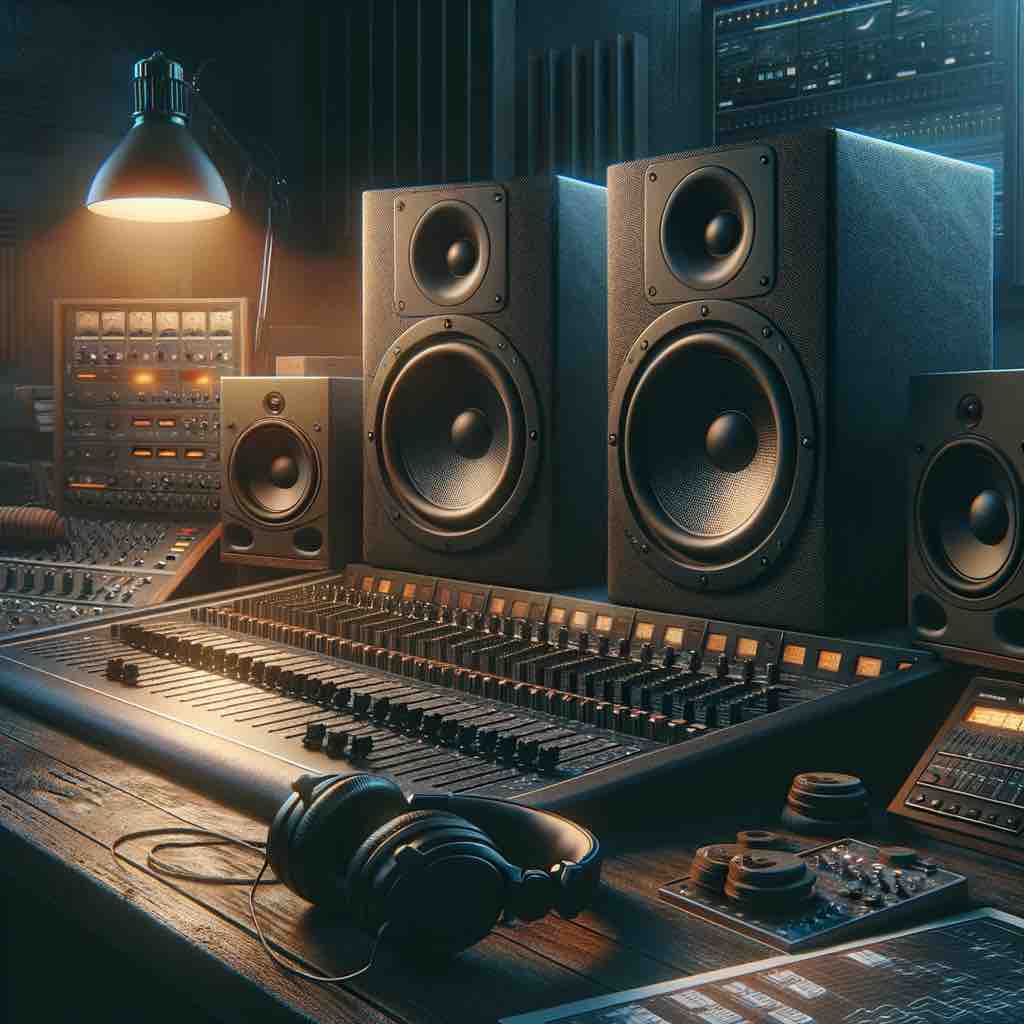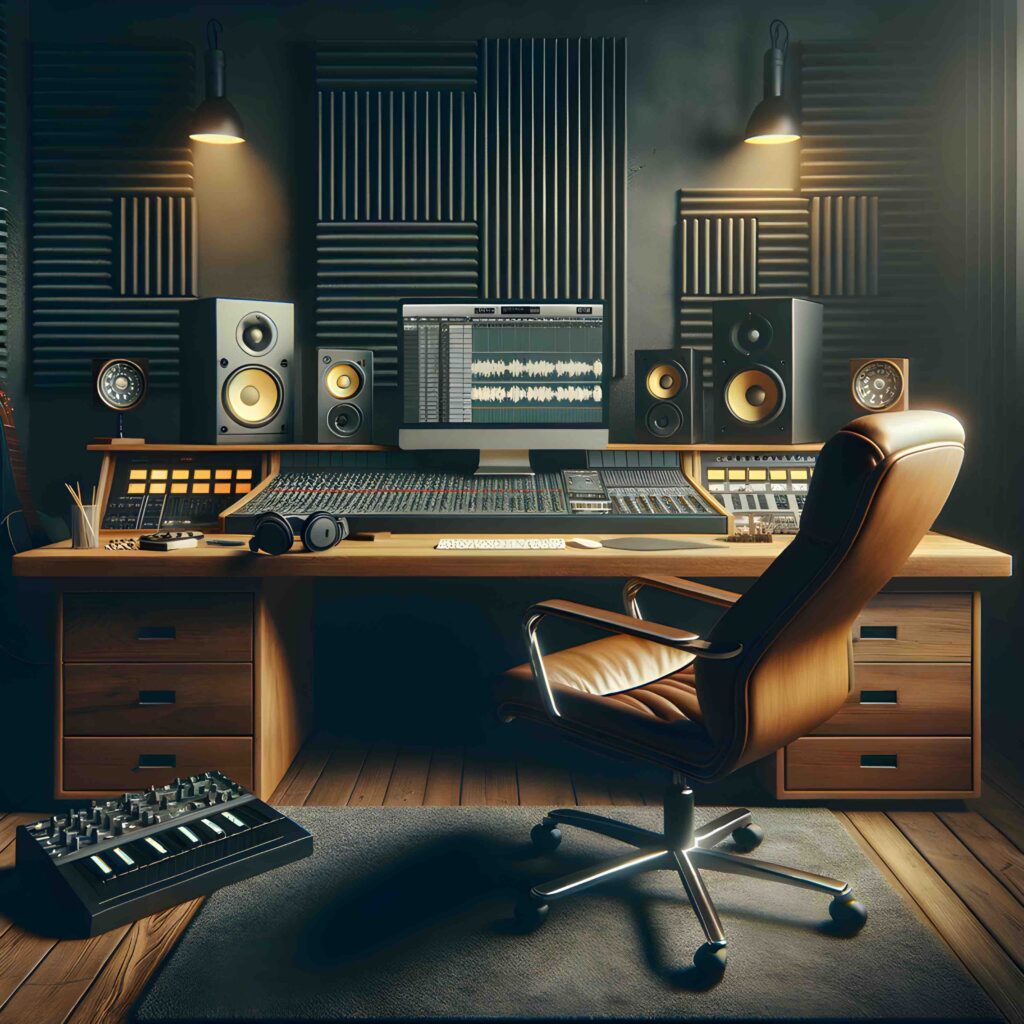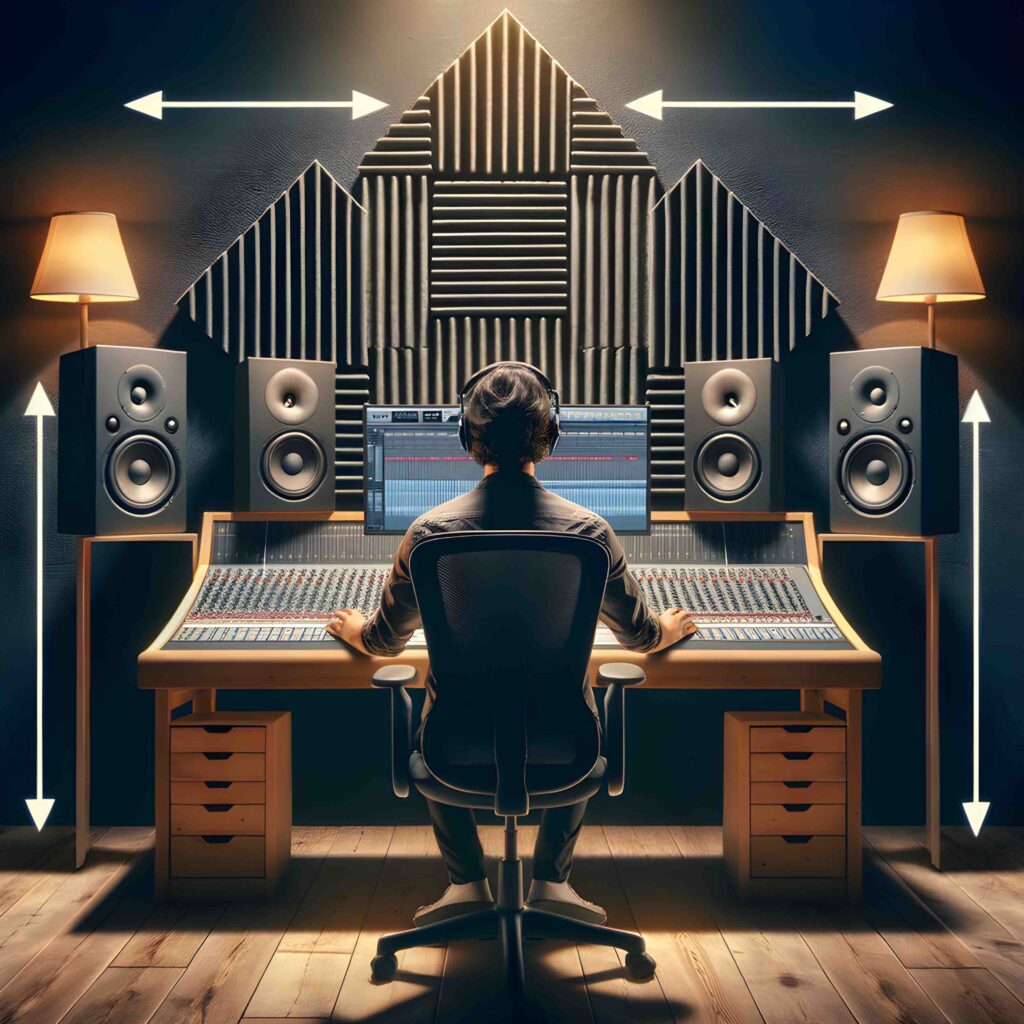Alright, audio enthusiasts, we’re going to explore the world of studio monitors – the unsung heroes of every mixing and mastering journey!
I’m sure you all have rocked out to your favorite songs on regular speakers, right? But studio monitors aren’t your average speakers – they’re the sonic architects, created to reveal all the hidden details and unadulterated truth about your mix.
So, grab a front-row seat as I explain the magic of studio monitors and decode why they’re not just speakers on steroids – they’re the secret sauce to your mixing mastery!
Overview
Have you wondered why your beats sound awesome in a studio but fall flat everywhere else? Enter stage left: studio monitors!
These aren’t your grandma’s speakers – they’re the secret sauce for producers in the know.
Consider them your best friends in audio, divulging all the filthy secrets of your mix.
Studio monitors allow you to hear every detail in your music, from the faint sizzle in the hi-hats to the bass drop.
They’re like the truth serum for music.
They’re here to keep it real, not sugarcoat.
But what are studio monitors?
What separates them from regular speakers?
How should you set them up in your studio?
And the burning question we all want to know when shopping for studio gear: are they worth the expense?
We’ll answer these questions and more. Keep reading, we’re just getting started!
What are Studio Monitors?

Studio monitors, sometimes referred to as reference monitors are a kind of loudspeaker designed for professional audio production settings such as recording studios, radio broadcasting studios, and film post-production facilities.
You’ll need a pair of studio monitors if you want to maximize the sound-quality that you can produce from your home studio.
Why, you ask?
Studio monitors are made to reproduce sound accurately and transparently.
Contrarily, consumer speakers aim to improve sound quality for a wider audience.
Monitors are vital in an audio production setting because it’s your job to improve your audio quality – not your speakers.
You’ll improve your audio quality in the mixing and mastering stage. To do so, you’ll need to know that your recorded audio or instrumental actually sounds like.
Studio Monitors Have a Flat Frequency Response
In the audio engineering world, we say that studio monitors have a flat frequency response.
In other words, studio monitors reproduce audio frequencies – from the deep lows to the crisp highs – with equal accuracy. They don’t emphasize or de-emphasize any frequencies for the listeners enjoyment.
A studio monitors’ flat frequency response enables you to make well-informed choices on dynamics, equalization, and leveling.
It guarantees that the sound you hear is a true depiction of the audio, enabling you to spot and fix any problems in your mix.
Main Takeaway
The main objective of studio monitors is to provide a neutral and accurate depiction of your audio, enabling you to make crucial choices during the mixing and mastering phase.
What Role Do Studio Monitors Serve in Digital Audio Recording?
Studio monitors play a crucial role in a home recording studio by they provide the last point of reference for accurately reproducing and evaluating audio recordings.
You’ll need to use an audio interface to connect your monitors to your computer. This interface serves as a middleman, ensuring that your sound quality stays true to its original version.
Here’s an example to illustrate the role your studio monitors will play in your home studio. Let’s say your recording vocals through your microphone.
You’ll connect your mic to your audio interface which will send audio signals from your mic to your DAW.
To hear audio from your DAW, you can connect a pair monitors to your interfaces output ports.
Your computer will send audio from your DAW to your interface as digital signals which your interface will convert into audio signals.
From there, your interface channels these audio signals to your studio monitors.
Digital Audio Recording: Converting Digital and Audio Signals
The digital audio recording process that involves converting analog signals and digital signals, sometimes multiple times.
Therefore, it’s important to ensure that the equipment that your using maintains the highest standards of accuracy.
You don’t want to be boosting or cutting frequencies based on inaccurate representations, as it can lead to a mix that sounds different on various playback systems.
Whether it’s adjusting the EQ, tweaking compression settings, or fine-tuning the reverb, you want to be confident that the changes you make are translating accurately.
Studio Monitors vs Speakers: What’s the Difference?
Manufacturers design studio monitors to reproduce sound accurately.
They do this by ensuring that their monitors have a flat frequency response.
Studio monitors’ flat frequency response ensures that every frequency is reproduced as accurately as possible.
This flat response ensures that you have a neutral canvas on which to work when mixing and mastering.
Contrarily, conventional speakers, tend to use coloration to emphasize particular frequencies to cater to individual listening preferences.
For instance, conventional speakers may emphasize bass frequencies to produce a more noticeable low-end.
This emphasis is deliberate to create a more pleasing listening experience.
Takeaway
Conventional speakers are designed to enhance your listening experience while studio monitors are engineered for accurate sound reproduction.
Monitors are an essential tool for audio producers who want to achieve professional-quality mixes. They’ll help you make informed mixing decision and reproduce audio with accuracy and transparency.
Quick Fact: Where Does the Name Studio Monitors Come From?
Studio monitors are called as such because they are designed recording studio settings. They serve as the primary reference point for monitoring and evaluating audio in professional recording environments.
In audio production, we refer to monitoring as the process of listening and evaluating audio content to hear and assess the various elements of a mix or a master.
Monitoring allows engineers to make informed decisions about the levels, panning, equalization, and other processing applied to individual tracks within a mix.
Accurate monitoring is crucial for achieving a well-balanced and cohesive sound.
The Anatomy of Studio Monitors

A studio monitor is a complex device made up of three main components, all of which are necessary to produce high-quality audio. The tweeter and woofer are the drivers or speakers that are at the core of a studio monitor.
Let’s go in-depth on these components to understand what role they play in delivering transparent and high-quality audio.
Tweeter
The tweeter is responsible for handling the high-frequency sound range, which allows a studio monitor to reproduce clear, detailed sounds like vocalists, cymbals, and other high-frequency sounds above 2 kHz.
Woofer
In contrast, the woofer manages the low-frequency range such as the bass and lower midrange frequencies to give the sound depth and richness. Together, the two drivers create a rich, well-balanced sonic spectrum.
Cabinet
Surrounding these drivers is the cabinet, the enclosure that houses and shapes the sound the drivers produce.
The cabinet’s design and materials effect the resonance of the studio monitor.
A well-crafted cabinet minimizes undesirable vibrations and coloration, creating a more accurate representation of the original audio signal.
The Tweeter, Woofer, and Cabinet
In summary, the tweeter, woofer, and cabinet are integral components of a studio monitor, working together to deliver a precise and faithful reproduction of the audio being monitored in a professional recording or mixing environment.
In conclusion, a studio monitor’s tweeter, woofer, and cabinet play pivotal roles in providing an accurate and authentic audio representation in your recording studio.
Understanding these components is crucial for you to make an informed decisions when buying studio monitors for your needs.
Active vs Passive Studio Monitors
Studio monitors come in two forms: active and passive.
Terms You Should Know
Amplifier
An amplifier serves as the powerhouse that drives a speaker by converting electrical signals into audible sound. For studio monitors, the amplifier can be either external (for passive monitors) or integrated directly into the speaker enclosure (for powered or active monitors).
Enclosure
The term “enclosure” refers to the housing or casing that holds the speaker components. Keep in mind, the enclosure is not just a protective shell; it contributes to the speaker’s acoustic characteristics.
Active
Audio professionals often use the terms “active” and “powered” interchangeably, leading to some confusion. Unlike passive monitors, active studio monitors have amplifiers built into their enclosures. This built-in amplifier eliminates the need for external amplification.
Passive
Passive studio monitors, unlike their active counterparts, don’t have integrated amplifiers.
Rather, they depend on external amplification, which means that to power the speakers, you must choose and connect an external power amplifier.
This design choice allows for more flexibility to customize the amplification system according to your preferences and requirements.
Do Active Speakers Sound Better than Passive Ones?
The debate between active and passive monitors often revolves around sound quality.
Do Active Speakers Sound Better than Passive?
Active monitors bring a lot of advantages to the table.
Active speakers provide a simplified integration between the amplifier and the speaker components because they come with built-in amplifiers.
This direct connection ensures that the speaker’s amplification matches its design. Using an external amplifier with passive speakers can make it harder to attain this synergy.
Furthermore, integrated signal processing features are frequently found in active speakers. These controls can give you more control over EQ and frequency adjustments.
How to Connect Studio Monitors to a PC or Mac Computer
First things first: determine if your studio monitors are passive or active.
How to Connect Active Monitors
Since active monitors have built in amplifiers, the process is really simple.
Just connect the monitors straight to your audio interface’s output using XLR or TRS cables. Most audio interfaces will connect to your computer via USB or Thunderbolt.
How to Connect Passive Monitors
You’ll need an external amplifier when using passive monitors.
You’ll need additional speaker cables to connect the amplifier to the passive monitors. Then you can connect the amplifier to your audio interface.
Lastly, connect your audio interface to your computer.
How to Position Studio Monitors for Optimal Sound Quality

To ensure that you hear an accurate representation of your mixes, position your studio monitors at an equilateral triangle with your listening position.
The goal is to form an imaginary triangle with the monitors and your head.
This configuration reduces possible acoustic problems and aids in producing an accurate stereo image. The stereo image can be distorted by positioning your monitors too close together or too far apart, which can alter how you perceive instruments and voices in your mix.
Additionally, consider tilting your monitors slightly inward, toward your listening position.
Also, try adjusting the height of the monitor to get the tweeters to line up directly with your ear level.
Aim for symmetry in your mixing space and add acoustic treatments where needed to further reduce unwanted reflections and bass build-up.
By following the equilateral triangle rule, you’ll allow your monitors to distribute sound evenly. You’ll also minimize the effect of room reflections and optimize your mixing experience.
Do I Need a Stand for Studio Monitors?
Although it’s not necessary, using specialized stands for your studio monitors can have a several benefits.
First, stands can raise your speakers to ear level, creating an immersive listening experience.
Stands allow you to precisely adjust your monitor placement, enabling you to form an equilateral triangle with the listening position.
Additionally, elevating speakers off your desk lessens the possibility of unwanted vibrations that could distort the sound.
Using stands for your monitors enhances the aesthetic appeal of your studio and helps refine the playback quality in your home studio.
Are Bigger Studio Monitors Better?
Bigger studio monitors or smaller ones?
Larger studio monitors usually provide a more noticeable low-frequency response, which makes them great for mixes where bass accuracy is critical.
However, consider your room’s dimensions, as large displays can overwhelm your listening area and result in inaccurate sound reproduction in smaller settings.
In terms of overall accuracy and detail, smaller, higher-quality monitors might do better than their larger, lower-quality equivalents.
Wrap Up: Are Studio Monitors Necessary?
Studio monitors are necessary in a home recording studio.
Studio monitors, as opposed to consumer speakers, are designed to have a flat frequency response.
You’ll need monitors with a flat frequency response to make informed decisions about tonal balance, dynamics, and EQ adjustments.
Since monitors are transparent, the sound you’ll hear is a more accurate depiction of your original sound source, free from any coloration that may come from consumer speakers.
Conclusion
Studio monitors are essential for anyone serious about producing studio-quality audio from home.
Unlike consumer speakers, studio monitors have a flat frequency response, providing a more accurate representation your playback audio.
This accuracy allows you to make informed mixing and mastering decisions.
Furthermore, studio monitors reveal nuances and imperfections that may go unnoticed on consumer-grade speakers, ensuring that your final product meets professional standards.
Studio monitor location is also crucial to achieve the best possible sound quality.
You can optimize your monitoring experience by following the equilateral triangle rule. This rule encourages you to position your monitors to form an imaginary equilateral triangle with your listening position.
This arrangement helps maintain a balanced stereo image and ensures accurate representation of your mixes.
Ultimately, investing in high-quality studio monitors and strategically positioning them in your mixing space are key steps towards achieving professional quality audio in your home studio.
Frequently Asked Questions
Should You Mix Using Studio Monitors or Headphones?
Selecting whether to mix on speakers or headphones is straightforward. You should mix using both. The benefit of mixing on studio monitors that they produce a more natural listening environment, allowing you to perceive the depth, width, and placement of each element within your mix more accurately.
However, the precision of your mix could be impacted by the acoustics of the room.
Conversely, headphones provide a more immersive and segregated listening space, allowing for an accurate analysis of individual components in your mix.
They’re especially helpful in picking up on minute details and guaranteeing a consistent experience between different playback systems.
Why Are Studio Monitors So Expensive?
Studio monitors are more expensive than your average speakers.
Why?
First off, a major portion of the total cost is due to careful engineering and design needed to create studio monitors with a flat and precise frequency response.
High-quality parts—such as dedicated drivers and amplifiers—are necessary to guarantee accuracy in sound reproduction.
Furthermore, manufacturers frequently spend money on R&D to incorporate state-of-the-art technologies that improve functionality, dependability, and consumer convenience.
Extensive testing and quality control procedures raise the price even further while guaranteeing that every monitor satisfies high requirements.
Another factor is building sturdy, acoustically designed cabinets to reduce interference and resonance.
Why Do People Put Studio Monitors Sideways?
For both practical and acoustical reasons, monitors are frequently positioned sideways, or in a horizontal posture.
Although most speakers are oriented in a classic vertical layout, there are scenarios in which it can be more beneficial to place monitors horizontally.
One reason is optimizing sound dispersion across a larger horizontal listening region. This method can be helpful when the listener or mix location is outside of a small, sweet spot.
How Long Should Studio Monitors Last?
A studio monitor’s lifespan is influenced by several variables, such as usage habits, ambient conditions, and monitor quality.
Reputable manufacturers’ studio monitors can live up to ten years or longer if they are properly maintained.
You may increase their lifespan through regular maintenance and keeping them out of severe conditions.
It’s crucial to remember that technology advances and consumers may decide to replace their monitors for newer versions with more features.
When deciding whether to upgrade or replace your monitors, you can make well-informed judgments by keeping an eye on technology advancements and audio industry trends.








